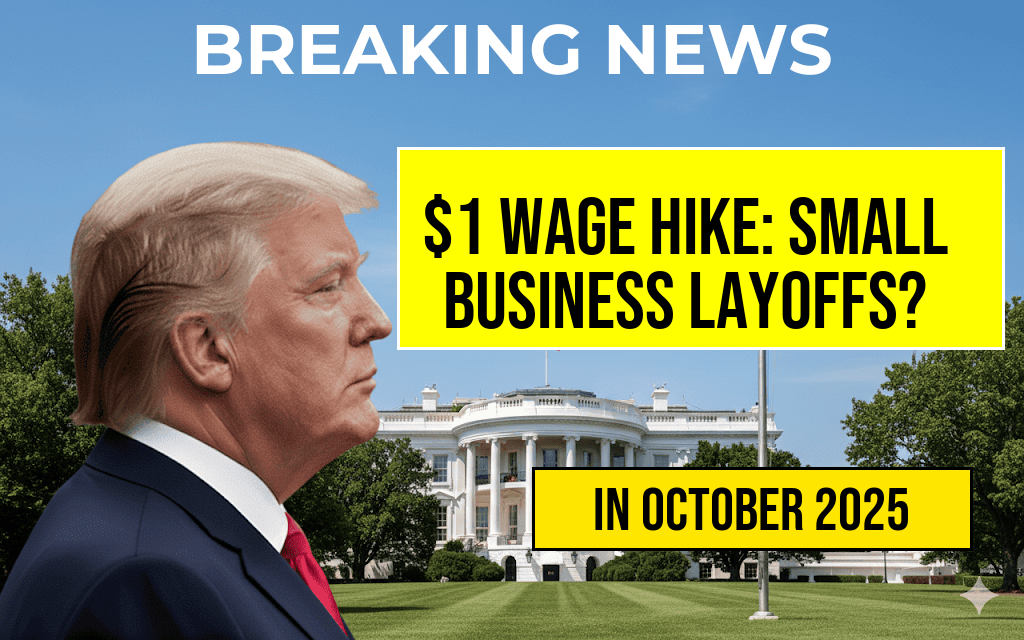As discussions around wage increases gain momentum, small business owners are grappling with the potential impact of a proposed $1 wage hike on their operations. The debate is intensifying, especially in light of ongoing concerns about automation and its role in the workforce. Many small businesses operate on thin margins, and a sudden increase in labor costs could force them to make difficult decisions, including layoffs. According to a recent survey conducted by the National Federation of Independent Business (NFIB), nearly 30% of small business owners cited labor costs as their top concern for the foreseeable future. With automation technology advancing rapidly, many are left wondering if a wage increase could accelerate the shift toward automated solutions, ultimately reshaping the landscape of small business employment.
Understanding the Wage Increase Proposal
The proposed wage increase has garnered attention from various stakeholders, including labor advocates and small business associations. Supporters argue that a $1 increase is a necessary step toward ensuring a living wage for workers. They assert that higher wages can lead to increased consumer spending, which in turn could benefit small businesses. On the other hand, critics warn that such an increase could disproportionately affect smaller enterprises that may not have the financial cushion to absorb the added costs.
Impact on Small Businesses
Small businesses are often characterized by limited resources and a strong reliance on local markets. As such, any increase in operational costs can have a significant effect. According to the U.S. Small Business Administration, small businesses represent 99.9% of all U.S. businesses and employ nearly half of the private workforce. This makes them particularly sensitive to changes in wage policies.
- Profit Margins: Many small businesses operate with profit margins below 10%, making a $1 increase in wages a potentially steep hurdle.
- Employee Retention: While higher wages may improve retention, the cost may lead to layoffs if businesses cannot sustain their workforce.
- Automation Adoption: Increased labor costs may accelerate the adoption of automation technologies, as businesses seek to maintain profitability.
Automation: A Growing Concern
The fear that wage increases could lead to layoffs is compounded by the rapid advances in automation technology. Many small businesses are already exploring automated solutions to reduce labor costs. A report from the McKinsey Global Institute indicates that up to 30% of the U.S. workforce could be displaced by automation by 2030. The potential for job loss raises questions about the future of employment in small businesses.
Balancing Act: Wages vs. Automation
For small business owners, the decision to increase wages or invest in automation is a delicate balancing act. The following factors play a crucial role in this decision-making process:
| Factor | Wage Increase Impact | Automation Impact |
|---|---|---|
| Cost of Labor | Increases operational costs | Reduces long-term costs |
| Employee Productivity | Potential for increased morale | May reduce need for human labor |
| Market Competition | May lead to higher prices | Can maintain competitive pricing |
Voices from the Small Business Community
Small business owners are vocal about their concerns regarding a wage increase. Many express a desire to pay their workers fairly but fear that they will be unable to sustain their businesses in the face of rising costs. A bakery owner in Ohio stated, “I want to pay my employees a living wage, but if my costs go up too much, I might have to let some of them go.” Similarly, a local coffee shop owner noted, “The competition is fierce, and if I have to raise prices too much, I risk losing customers.”
Possible Solutions
To mitigate the impact of wage increases, small business advocates suggest several potential solutions, including:
- Tax Incentives: Offering tax breaks to small businesses that increase wages could alleviate some financial pressure.
- Training Programs: Investing in employee training can enhance productivity, helping businesses offset higher wages.
- Collaborative Workspaces: Encouraging shared resources among small businesses can reduce overhead costs.
As the debate continues, the effects of a proposed wage increase on small businesses remain uncertain. The interplay between higher wages and automation will undoubtedly shape the future of work in America, making it crucial for policymakers to consider the unique challenges faced by small enterprises.
For more information on the impact of wage policies on small businesses, visit the National Federation of Independent Business or read the latest insights from Forbes.
Frequently Asked Questions
Will a $1 wage increase lead to layoffs in small businesses?
While a $1 wage increase may strain small businesses, it does not necessarily mean they will lay off workers. Many businesses might adjust their operational costs or find efficiencies to accommodate the wage increase.
How does automation impact the decision to lay off workers?
Automation can play a significant role in workforce decisions. As businesses look to manage costs, they may invest in automated solutions that could replace certain jobs, potentially leading to layoffs.
Are there specific industries more affected by wage increases?
Yes, industries such as retail and hospitality are often more sensitive to wage increases due to their reliance on low-wage labor. These sectors may experience greater pressure to automate or restructure their workforce.
What strategies can small businesses use to cope with wage increases?
Small businesses can implement strategies like improving operational efficiency, investing in technology, adjusting pricing, or exploring alternative revenue streams to mitigate the impact of wage increases.
How might consumers react to small businesses raising prices due to wage increases?
Consumers may have varying reactions; some may understand the need for price adjustments while others might seek cheaper alternatives. The overall impact depends on the market dynamics and consumer sentiment.

Leave a Reply